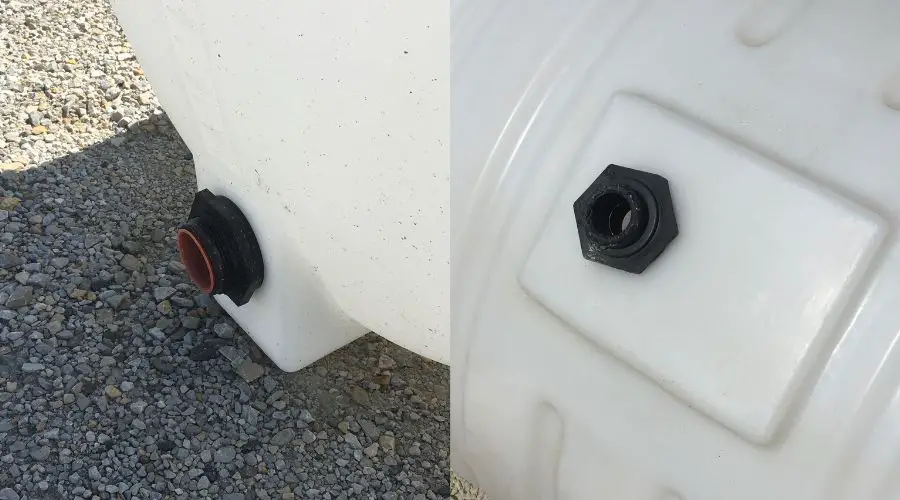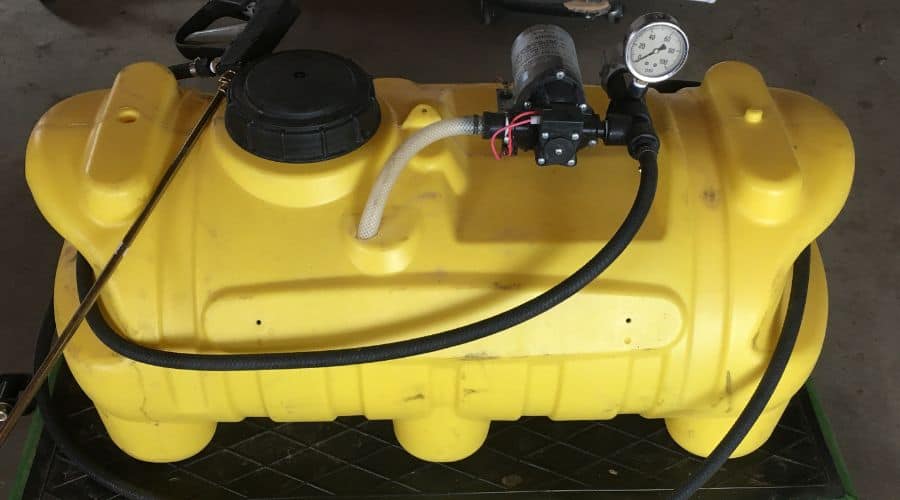There are many different types of sprayers. They vary in type of pump, boom size, pressure range, etc. One of the most prominent features of any sprayer is the tank size. Larger sprayers will allow you to spray more area without stopping, but they do cost more. Smaller tanks can be easier to transport, but too small and you will have to fill your tank more frequently, costing you time. So how do you decide on the right sprayer size for your application?
The right sprayer size for your needs will be determined by your sprayer type, (boom/boomless or spot sprayer), and your application rate (gallon per acre or GPA). Let’s examine how you can find the best sprayer size for your needs.
How Sprayer Type Affects Output: Boom Sprayers Vs Spot Sprayers
The amount of liquid that is applied by your sprayer over an acre depends on the method used to spray the liquid. There are two main sprayer types: boom sprayers and spot sprayers. With a spray boom, it is easy to determine the number of gallons that are applied per acre, with a spot sprayer it is more difficult to determine.
Booms evenly apply your spray across a series of evenly spaced nozzles at a constant (or close to) speed. Spot spraying is inconsistent, figuring the size of the spot sprayer you need may take some trial and error but this guide should get you close.
Boom sprayers
Any sprayer using nozzles on a boom or boomless setup to cover a field or specified area.
Examples: Ag sprayers, de-ice, dust control trucks, boomless pasture sprayers, and UTV boom sprayers.
Spot Sprayers
Sprayers use a gun or spray wand to spray certain areas or specific pests. Harder to calculate a per acre rate.
Examples: 12-volt spot sprayers, hand pump sprayers, backpack sprayers, lawn and turf skid sprayers, and Tree sprayers.
How Application Rate Affects Sprayer Size
Your application rate is the amount of liquid that is applied per acre. It directly relates to how fast your tank will get empty. For boom sprayers, you simply divide the number of gallons your sprayer tank holds by your gallon per acre rate. For example, a 100-gallon tank will cover 10 acres if you are set up to apply a 10-gallon per acre rate.
How to Find Sprayer’s My Application Rate?
Finding your per acre rate requires calibrating your sprayer. There are a couple of different methods to use. You can see a simple explanation of calibrating a boom sprayer in this post on calibrating ATV sprayers. If you are using a spot sprayer then this post will show you how to calibrate your sprayer.
Essentially, you need to spray an acre at a constant speed with water only and then measure how many gallons you used. This is the simplest method, but if you do not have a sprayer, you obviously can’t do a trial run. So what should you do? Well, if you know some specific information about the sprayer you want to buy, you can do some math to see the gallons that sprayer will spray per acre.
How to Calculate How Many Acres a Sprayer Can Cover
To calculate a sprayer’s per acre output you need to know these 3 things. The gallon per minute flow rate of the sprayer nozzles. The width (in inches) between spray nozzles, and the speed (mph) you will travel while spraying.
You would then use those numbers in this formula: Gallon Per Acre = 5940 x GPM / mph x width. For a full guide to calculating sprayer output, check out this post on sprayer calibration that explains it in greater detail.
You should be able to find this information about any sprayer that is for sale. Let’s use this sprayer as an example: Workhorse 25 Gallon Deluxe ATV Sprayer.

When you look at the listing on Amazon there is a lot of information. It tells you the number of nozzles, tank size, pump capacity, and some other details. However, it does not tell us the essential details we need to calculate the gallons it will use per acre. So I decided to reach out to the manufacturer and they directed me to the user manual for this model. In the manual they provide this chart which contains the information we need:

It tells us the nozzle capacity at 20, 30, 40, and 50 psi. It also provides rates for different speeds. Finally, the nozzle spacing is shown as 20 inches. So we would plug in our spacing (20 inches), the nozzle capacity (.20 @ 40 psi), and your speed into the formula from above. This would tell you the total gallons sprayed per acre.
This chart provides us with the gallon per acre rate so we don’t need to calculate this unless you plan to spray at a speed faster than 10mph or use a different nozzle size than the one that comes on the sprayer.
Looking at the chart let’s say you want to drive 5 mph with this sprayer at 40 psi. That would mean your per acre output is nearly 12 gallons. Since the sprayer capacity is 25 gallons, you can expect to cover about 2 acres with one tankful.
You may not find this much info in all sprayer manuals, but you should at the very least be able to find the nozzle spacing and nozzle capacity. You might just have to call the manufacturer. Or purchase your own nozzles separately so you are certain of the size. If you are new to sprayer nozzles you can learn all about choosing a nozzle in this post and about the different nozzle sizes in this post.
Acres Covered By Different Sprayer Sizes
I have put together this chart as a guide to show common sprayer tank sizes and how many acres you can cover with them. While tank size is important, the real important factor is how many acres can a certain amount of water cover. When the chart says “tank size” it is referring to the number of acres covered by that amount of water. We are assuming a 300-gallon tank is full, so 300 gallons of water will cover 15-60 acres depending on your per acre rate.
| Tank Size (Gallons) | Acres Covered (5 GPA Rate) | Acres Covered (10 GPA Rate) | Acres Covered (15 GPA Rate) | Acres Covered (20 GPA Rate) |
|---|---|---|---|---|
| 15 | 3 | 1+ | 1 | <1 |
| 25 | 5 | 2 | 1+ | 1+ |
| 50 | 10 | 5 | 3+ | 2.5 |
| 100 | 20 | 10 | 6+ | 5 |
| 150 | 30 | 15 | 10 | 7+ |
| 300 | 60 | 30 | 20 | 15 |
The top row shows different application rates. As we discussed above, your rate affects how many acres a tankful can cover. A higher application rate will mean that you can cover fewer total acres. The left column shows different spray tank sizes. Not all rates and tank sizes are included. But, remember that you can easily calculate the approximate output per acre with the right information. Then you can get an idea of how many acres a certain tank size will cover.
This chart is meant as a guide and starting point. Every application is a little different and you might opt for a little larger tank to ensure you can cover plenty of ground. You may also prefer a smaller tank for cost and transportation reasons.
Other Things to Consider When Choosing Sprayer Size
Choosing a sprayer size is more than just how much area you can cover. It might be the primary factor but there are several other things to consider.
Transportation/Storage
You may be limited by the size of the sprayer that you can store or transport. Sprayer tanks are lightweight when empty but they do take up a lot of room. It is strongly advised to store your sprayer inside whenever possible, so consider your available storage space when looking for a sprayer.
ATV/Tractor Size
Water weighs just over 8 pounds per gallon. This means a sprayer with a 100-gallon capacity tank will weigh over 800 lbs when full. Is the vehicle or tractor you will be using with this sprayer large enough to accommodate this weight? This is particularly crucial for 3-point sprayers that will be used on small lawn and garden tractors.
Access to water
Refilling your sprayer tank is time-consuming, particularly for large tanks. This becomes an even larger issue when you are spraying a remote area far from access to a water supply. If you spray pastures, food plots, or any area far from a water source, you may want to go with a larger tank. This will ensure you always have enough liquid to complete your job without having to travel to refill the tank.
Tank shape
As with tank size, there are numerous different tank shapes available as well. Tank shape affects how liquid drains out of the sprayer. This should be taken into account when considering the size sprayer tank you need. Just because two different sprayers have the same capacity tank does not mean they will necessarily cover the same area.

A 25-gallon tank with legs or flat bottom will not drain as well as a round tank or tank with a sump. Just like the Workhorse Sprayer above, many spot sprayers or ATV sprayers draw liquid through a hose from the top of the tank. This suction hose might not get all the liquid out. This means you may have a gallon or more of your liquid in the tank even though no liquid is coming out of your nozzles. Therefore you won’t cover as much area as a tank that drains completely.

This is a spot sprayer I built years ago. Suction hose draws liquid from the tank. It can be hard to completely drain tank, especially on when the tank is sitting on an incline.
Bottom Line
Sprayer tank size is important and it might be the first thing you consider about a sprayer. Choosing the right size comes down to your needs and knowing what your application rate will be.

